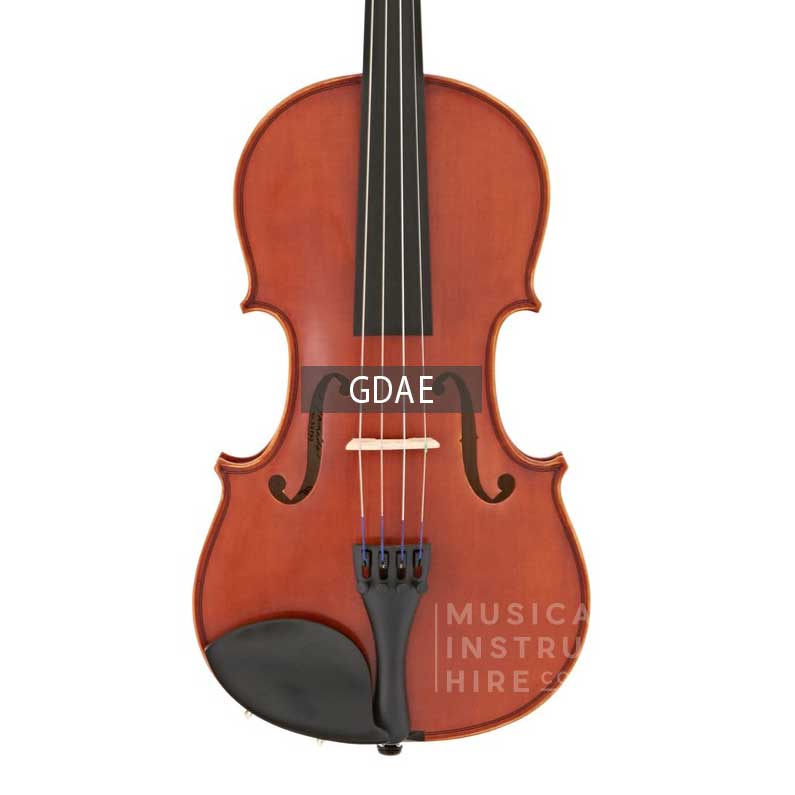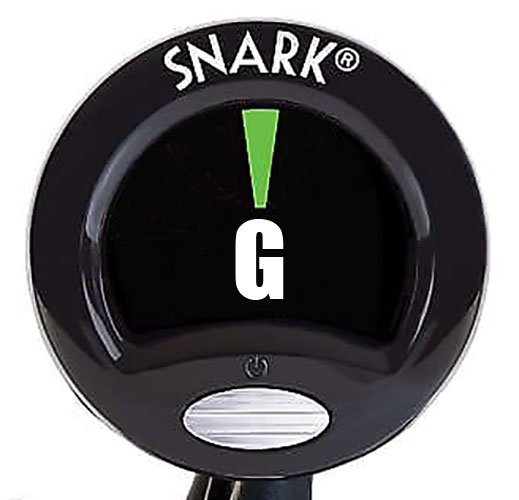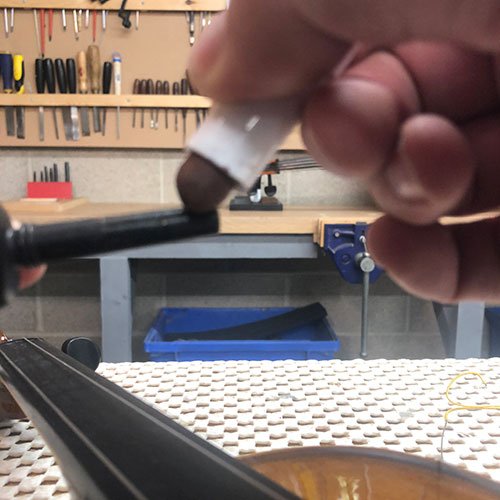Before You Start - The Basics
Before getting stuck in, there are a few points to take into account before you start. Familiarising yourself with this basic points will make tuning your violin/viola a lot easier. If your violin/viola is brand new, it may also be worth checking the bridge position before you start, and knowing the parts of the violin/viola can be very useful.
The notes of the violin
All violins have 4 strings which are G, D, A and E – G is the lowest in pitch and the thickest string, and E is the highest in pitch and the thinnest string. As you hold the violin facing you, they are strung left to right in this order. Viola strings are C, G, D & A.
When the violin/viola is set up (made ready for the player) the strings are stretched along the length of the violin/viola and wound at the top by a peg. They have a degree of stretch but will happily snap if stretched too far. The thinner strings are more likely to snap than the thicker strings.
The teacher will almost always tune the violin/viola for their young or beginner students, but the temptation is always there to have a go.
New students often fancy giving the tuning a go, and once it has gone properly out of tune with experimentation it is quite tricky to know how to get it back in tune.

Violin/Viola Strings
Lower quality strings can be extremely difficult to tune, and just as hard to keep in tune. If you are unsure of the strings you have currently then the colour and pattern of the winding at the bottom of the string will tell you the manufacturer, and the top winding the note.
The strings on a quality student violin/viola will normally be synthetic core strings and made from a variety of materials. They are durable and ideal for giving a stable sound to the student.
We use D’Addario Ascente strings on our smaller hire violins/violas and D’Addario Helicore on our ¾ and full-size instruments. We have found that these strings are by far the most pitch stable.

How The Violin/Viola Is Tuned
There are two ways a violin/viola can be tuned. Tuning pegs for larger adjustments, and when new strings are being fitted, and the fine tuners.
Fine Tuners
If only slightly out of tune, the fine tuners may be used. Turning a screw clockwise will tighten the string and the turn of a screw anticlockwise will loosen it.
Pegs
The pegs are used for making larger adjustments. It is worth noting that even the slightest turn of a peg is often all that is required to tune your violin/viola. Anticlockwise movements tighten the string, clockwise movements loosen the string.

Tools for the job
Violin/Viola Tuner
One of the most common ways to tune any instrument is the use of a tuner. A chromatic tuner will tune a violin/viola, but also any other instrument, and will often clip on the the violin/viola.
You pluck a violin/viola string and the tuner will tell you what note it is currently. When the note is either sharp or flat, the tuner will show this with the needle. As you tune up & down, the needle will eventually fall in the middle.

Violin/Viola Tuning App
Tuning apps have become extremely popular, having one installed on your phone means it is always with you.
There are free and paid for versions, the free versions are OK but aren't as user friendly. For the price, its worth investing. They work in the same way as the violin/viola tuner, pluck a string and it will tell you currently what note is being played. They will then have a visible display to show if it is sharp or flat.

Other Instruments
The violin/viola can be tuned to another instrument (providing you know it is in tune!)
The most obvious is the piano, simply playing the note of each violin string and tuning to it. Without practice this is not an easy way to tune.
You can also use a tuning fork, this will sound a note and you tune a single string to it. The other three strings are then tuned to it, a lot of practice will be needed to tune in this way.

Tuning Your Violin/Viola
We'll assume you have either a violin/viola tuner, or downloaded a tuning app, when you are starting out it is the only way to do it.
Top Tip - It will always be better to be to low, then high, strings do not snap when the are too low! If you are ever unsure, and the sting is getting really tight tuned back down and work you way back up.

Plucking the G string (thickest on a violin), or the C string on a viola the tuner will tell you what note the string is currently tuned to. I this case the note is F or B, if you are unsure you can use the piano image below to make it easy.
If you are already familiar, you know that this will need tuning up to G or C. To tune up you need to turn the violin peg anti clockwise until the tuner display 'G' or "C" note.

Once you have the correct note displayed on the tuner, it is time to get it as close as possible using the pegs at first.
It is always wise to tune down first, just a little, and tune up with one smooth turn.
If you are ever unsure, and think you may have gone to far, then it is safer to tune down a little and work your way back up. Slack strings do not snap, but over tightened can easily break!

When you have got close with the pegs tuning, you can if needed finish with the fine tuners. These will allow you to get the note perfect, and the tuner will display green and/or needle will be in the middle.
Once you have it in tune, you can start on the next. As you move through the strings, tuning one increases the tension on the violin/viola, and can put your tuned strings back out of tune, you may need to work through them all a couple of times to fine tune them.

The pitch between all the notes are a 5th and new string players will learn to hear this interval between notes and once one string is in tune you can play the next string together and hear what tuning is needed.
Tuning is all part and parcel of learning the violi/violan and not something to be afraid of. All instruments have their idiosyncrasies and it is all part of the learning journey of your chosen instrument.
All of our hire violins/violas arrive ready to play, they can sometimes lose their tuning slightly in transit, but not much. It is a lot easier to tune a violin/viola that is very nearly in tune, than starting from scratch!
Common Problems when Tuning a Violin/Viola
Slipping & Sticking Pegs

Pegs can sometimes stick,
String Winding

Badly wound strings can cause the peg to slip. In the example above, you can see how the string wind does not run straight. As you increase the string tension, the string is actually trying to pull the peg out.
Leaning Bridge

As you tune the violin/viola, it is a good idea to keep an eye on the bridge angle. Tuning, can cause the bridge to lean backwards, if you spend the time tuning, and correct this at the end, you'll find it alters the tuning.





